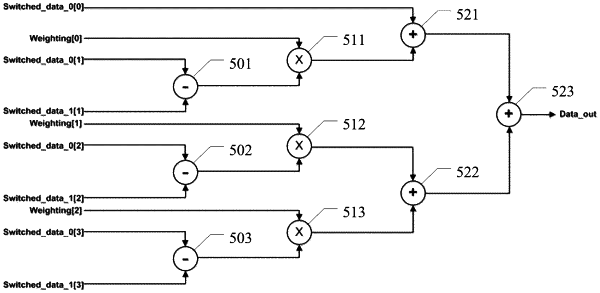| CPC G06T 17/20 (2013.01) [G06F 17/17 (2013.01); G06T 15/08 (2013.01)] | 5 Claims |

|
1. A device comprising a memory and a processor, wherein the memory has computer instructions stored therein, and when the processor executes the computer instructions, cause the processor to:
obtain coordinates of an interpolation point in a sampling space, a side length of a cube formed of nearby eight sampling points surrounding the interpolation point in the sampling space, and mapping values of four vertices of a tetrahedron surrounding the interpolation point, wherein the four vertices are four out of the eight sampling points;
calculate a volume of the tetrahedron, and volumes of four sub-tetrahedrons formed of the interpolation point and arbitrary three vertices in the tetrahedron, based on coordinates of the interpolation point in the sampling space, and the side length of the cube formed of nearby eight sampling points surrounding the interpolation point in the sampling space; and
obtain an interpolation value of the interpolation point, based on a tetrahedral interpolation theorem formula, the volume of the tetrahedron, volumes of four sub-tetrahedrons, and mapping values of the four vertices of the tetrahedron;
wherein the device further comprises: a first subtractor, a second subtractor, a third subtractor, a first multiplier, a second multiplier, a third multiplier, a first adder, a second adder, and a third adder;
wherein for the first subtractor, a positive input terminal is applied with a mapping value of a fourth vertex of a tetrahedron, a negative input terminal is applied with a mapping value of a third vertex of the tetrahedron, and an output terminal is applied with a first input terminal of the first multiplier;
for the second subtractor, a positive input terminal is applied with the mapping value of the third vertex of the tetrahedron, a negative input terminal is applied with a mapping value of a first vertex of the tetrahedron, and an output terminal is applied with a first input terminal of the second multiplier;
for the third subtractor, a positive input terminal is applied with a mapping value of a second vertex of the tetrahedron, a negative input terminal is applied with the mapping value of the first vertex of the tetrahedron, and an output terminal is applied with a first input terminal of the third multiplier;
for the first multiplier, a second input terminal is applied with an X-axis coordinate data of an interpolation point in a sampling space, and an output terminal is applied with a first input terminal of the first adder;
for the second multiplier, a second input terminal is applied with a Y-axis coordinate data of the interpolation point in the sampling space, and an output terminal is applied with a first input terminal of the second adder;
for the third multiplier, a second input terminal is applied with a Z-axis coordinate data of the interpolation point in the sampling space, and an output terminal is applied with a second input terminal of the second adder;
for the first adder, a second input terminal is applied with the mapping value of a first vertex of the tetrahedron, and an output terminal is applied with a first input terminal of the third adder;
for the second adder, an output terminal is applied with a second input terminal of the third adder; and
for the third adder, an output terminal outputs an interpolation value of the interpolation point.
|